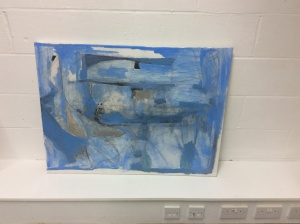Varda Caivano’s work is composed of colors and lines that recall nature or landscapes. The manner in which her work is intentionally kept unfinished, suggested by its unpainted areas, arouses a sense of its richness, and infinite possibilities, within the viewer’s imagination. The colors she uses have shifted from the brighter ones in her earlier work to quiet hues such as gray, blue, and brown; and the pencil lines embedded within the paintings are also unique to her work.
In the catalogue for Caivano’s solo exhibition at The Renaissance Society in Chicago in 2015, the art critic Terry Myers remarks as follows:
“Her colors challenge boundaries, initiate contradictions, establish continuities and agilities all at once, but also in sequence … Drawing plays an essential role in Caivano’s work. It is, in the end, what brings both clarity and complexity into the pictures. The painting described above contains a rectangle drawn in pencil that functions as if it were a frame within the frame of the canvas.”
(Terry Myers, “Change of Seen” in The Density of the Actions (The Renaissance Society at the University of Chicago, 2015)).
Caivano also works on a number of pieces at the same time. As she continues her experimentation, observation, contemplation, discovery, and decision-making, within her paintings colors, lines, material and brushstroke, and depth and density are expressed, and thus the traces of her thinking come to overlap with the voices and dialogues of the works. After this sense of relationality has developed for a certain period of time, a work reaches completion. This process is at the core of Caivano’s practice, and we may even observe within it the traces of the last one and half centuries of art history.
The relationship continues to unfold within the exhibition space as well. In her solo exhibition “Inner me” in 2009 at Tomio Koyama Gallery Kyoto, five paintings were exhibited on one wall in a row as if they were playing improvised music together. Caivano further experimented with the relationship between the works themselves, and that between the works and the exhibition space, in her solo exhibition “In the Studio” in 2013 at Tomio Koyama Gallery, by placing works on the floor in front of the paintings installed on the walls.
Art critic Minoru Shimizu observes of Caivano’s work as follows:
“Her art is an endless collage, composed of varied brushstrokes and unpainted white areas, individual works and the walls of the exhibition space, and the overall installation and position of the viewer … Caivano’s installations are like paintings, the individual works performing in the same way as separate strokes of the brush, and her paintings are like installations composed of discrete touches of paint. Caivano’s works are ‘untitled’ because they are, in principle, open ended. The viewer makes the next move, pushing the collage further and obtaining the freedom to perceive frames with diverse meanings.”
(Minoru Shimizu, “Vardia Caivano ? Exploring “Untitled” Games of Painting” in Vardia Caivano: “Inner Me” catalogue, Tomio Koyama Gallery, 2009.)
While at once being aware of surface effects on the picture plane, Caivano’s paintings attempt to establish contact points of time and space. They embrace both improvisation and orientation, and materiality and illusion, earnestly pursuing the possibilities of abstract painting.
This is Caivano’s third exhibition, and her first in three years, at Tomio Koyama Gallery, and features new work. The viewer is invited to discover how the works among themselves, and the works and the new gallery space in Roppongi, resonate with one another.











